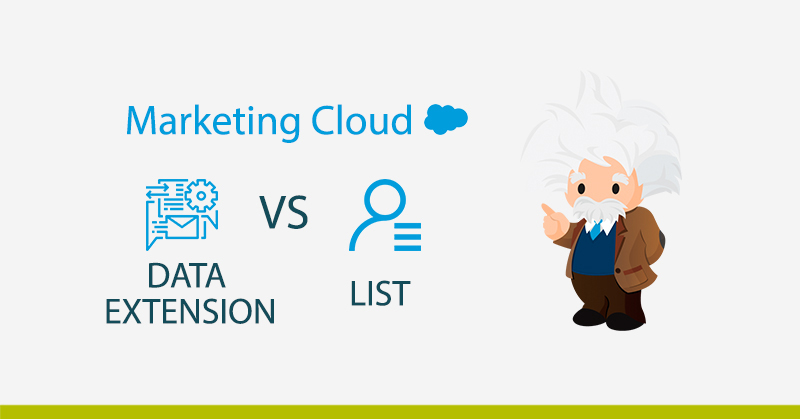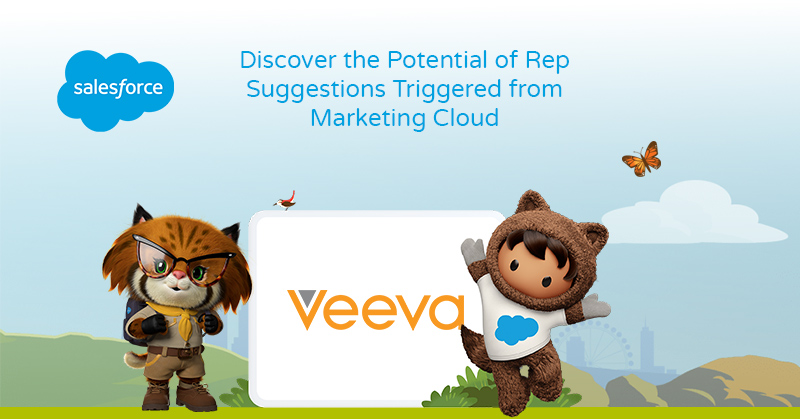When working in the Marketing Cloud, questions often arise about when to use a data extension or a subscriber list when uploading contacts. If you still have doubts and need to differentiate when to use one option or the other, you are in the right post.
This post focuses on the specific use of data extensions and subscriber lists in the Email Studio module within the Marketing Cloud. If you still do not know this module of the Marketing Cloud, we invite you to read the following article, which discusses in depth what is Email Studio: Email Studio in the Marketing Cloud: what is it and what it offers. On the other hand, if you still do not know the Cloud Marketing platform or have not been clear about some concepts about it, you can visit the following article to familiarize yourself with it and know What is Cloud Marketing? The Salesforce Digital Marketing Hub.
Data extensions vs listas de suscriptores
On the one hand, a data extension is a table within the application database (in this case Cloud Marketing) that contains your data. You can use it to store a list of contacts (to send them an email, for example) but it can also be used to store any type of information (products that a customer has bought, history of contracting services). In short, you can use a data extension to store subscriber information (as you do with lists) or to store relational data for these subscribers.
On the other hand, a subscriber list in the Marketing Cloud is basically a compilation of subscribers who receive your communications. Therefore, you can create as many lists as you want in order to segment the subscribers to your liking and make more personalized communications.
Data extensions are very similar to tables in a database. They are usually related to each other and serve to keep your contact information as complex as you want. A list on the other hand is the simplest way to store contacts is like the previous step to using a Data Extension.
If you need to keep only contact information to work in Email Studio (First Name, Last Name, Company, Communication Preferences) you can do it with a Data Extension or a List. If you need something more advanced like maintaining the list of products a customer has purchased, you can only do it with a Data Extension since you will need to create several tables related to each other.
Why are there 2 ways to store data in the Marketing Cloud?
The answer has a lot to do with the evolution of the platform over the years. Before being acquired by Salesforce, ExactTarget was recognized as one of the best marketing automation platforms in the market. Subscriber lists were initially the only way to store user data but later developments in the platform and customers’ needs to maintain more complete data on their subscribers led to the emergence of Data Extension on the platform.
Which one should I use then?
In principle you could use either of the 2 forms as long as they are adapted to the use case of your project. If you want a personal recommendation, if you are starting a new project, Data Extensions are a safe option and the way recommended in general by Salesforce itself if you plan to increase your number of contacts in the future, maintain relational information about your subscribers or use an API to enter/query data. In short, both methods are very similar to the day-to-day operation of marketing campaigns.
Can I migrate from one option to another if I decide to change in the future?
If you want to change from a subscriber list to a Data Extension you can do so easily. It will depend on how you have implemented Cloud Marketing but it should not be difficult. You will need to plan on which Data Extension you will maintain the old lists and learn how to segment communications with the Data Extension.
Migrating from a Data Extension to a Subscriber List requires several decisions since you may have to do without data due to the limitations of the lists.
Main differences between data extension and list
Data extensions and lists may look similar, but in practice they have several differences. Some of them are:
- Lists are used only to store subscriber information while a data extension can be used to store any type of information.
- Lists are easier to use, require little technical knowledge and minimal configuration. While data extensions are more complex and extensive and allow for much more information to be included.
- Data extensions do not require the inclusion of an e-mail address to add a contact, while lists do.
- Data extensions are mainly used when you want to store and maintain user information that cannot be stored with the preferences of a list. This means that for example, if a user has multiple values for the same attribute, this cannot be stored in a list but can be stored in a data extension.
- Lists are generally used when you have a database of 500,000 contacts or less while data extensions support more than 500,000 contacts.
- There are functionalities specific to each element. For example, lists have standardized reports that data extensions do not have; data extensions can be shared among all company accounts, while lists cannot be shared, etc.
Structure of a data extension
A data extension is formed from the following components:
- Fields: Fields, as their name indicates, are fields that determine the information that can be stored and in the Marketing Cloud correspond to columns. The peculiarity of this component is that it is possible to create as many fields as needed for a Data Extension.
- Data Relationships: this type of relationship occurs when two data extensions are linked because they have a field in common within their tables. In general, this type of relationship is used to establish an advanced segmentation to include this type of segmented information in dynamic email content.
Structure of a subscriber list
A list of subscribers is formed from the following components:
- Email Address: The email address of the contact, this is required in the list but not in the data extension.
- Subscriber Status: The status defines the deliverability of the contacts. It can be active, bounced, held, unsubscribed and deleted. The main differences arise between bounced and held because if the contact has a bounced status, it cannot receive emails since 1 or 2 soft bounces or 1 hard bounce have occurred; while if it is in held status, the contact cannot receive emails since it has received 3 soft bounces or 3 hard bounces. If their status is unsubscribed, it means they have been removed from our list.
- Subscriber Key: is a unique value for each contact and serves to identify the contacts as first choice. Its use is not mandatory, and if it is not used, the email address serves as identification. A good use of the subscriber key is when you keep information of the same contact in different lists, since this value serves to identify the same contact in different lists.
- Profile Attributes: Profile attributes are the information that characterizes the contact. By default, the name and email address are mandatory and cannot be modified.
- Preference Attributes: These preferences define how a contact prefers to receive email communications. Both profile and preference attributes are very useful when creating groups within the Marketing Cloud and being able to offer dynamic content that adapts to their preferences.
Best practices for knowing when to work with one option or another
Both options are highly recommended for sending emails, however there are several scenarios to consider when using one or the other option.
The main scenario is the time you have available to create one element or another. If you have little time, the ideal is to create a list, since the steps are minimal. If the process is more complex, you have time and you want to include a large number of contacts, it is best to create a data extension, as they are more complex and elaborate but allow more options with their table model with editable fields.
The import speed is another scenario to take into account since a list is capable of importing 500,000 rows in one hour while a data extension is capable of importing twice as many rows in 10 minutes.
When you want to share a list with other departments, the ideal is to create a data extension since they can be shared among all the accounts within the company structure, while the lists cannot be shared.
The last scenario to be mentioned is when using exclusion lists versus suppression lists. Exclusion lists are normal lists, while suppression lists are data extensions, and their main difference is that in exclusion lists, the contact (with a subscriber status) is excluded from all contacts collected in the Marketing Cloud, while suppression lists are not included in the total count of contacts in the Marketing Cloud and therefore your contacts are available to send you communications if the data extension is valid.
Now that you know a little more about the use of lists and data extensions in the Marketing Cloud, if you have any other questions related to the Marketing Cloud or you want us to guide you in the implementation of it, do not hesitate to contact us, we will be happy to help.






